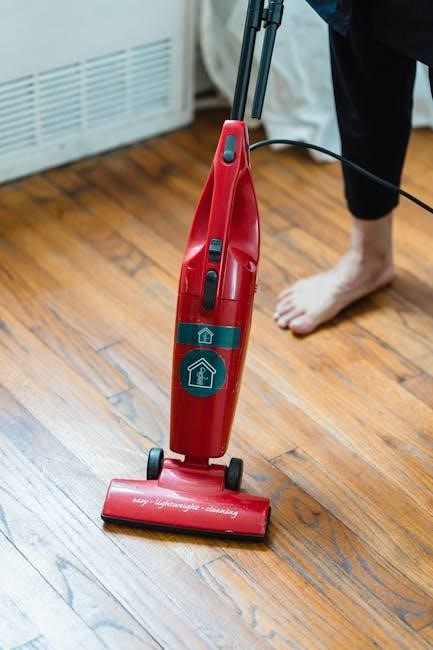Understanding GE electric range self cleaning instructions is crucial for optimal oven performance and safety‚ view the user manual online for specific guidance and recommendations today always.
Understanding the Importance of Self Cleaning
Self cleaning is a vital process for maintaining the overall health and efficiency of your GE electric range‚ ensuring a clean and safe cooking environment for you and your family.
The self cleaning feature helps to remove tough food residue and grime that can accumulate over time!
Regular self cleaning can also help to prevent the growth of bacteria and other microorganisms that can thrive in dirty ovens.
By following the recommended self cleaning instructions‚ you can keep your oven in good working condition‚ reduce the risk of maintenance issues‚ and extend its lifespan.
Additionally‚ self cleaning can help to improve the overall performance of your oven‚ allowing for more even heat distribution and better cooking results.
It is essential to understand the importance of self cleaning and to make it a regular part of your oven maintenance routine‚ as recommended by GE Appliances and other manufacturers.
This will help to keep your oven clean‚ safe‚ and functioning properly‚ and will also help to prevent any potential problems or issues that may arise from neglecting to clean your oven regularly.
Overall‚ self cleaning is a crucial aspect of oven maintenance‚ and should be done regularly to ensure optimal performance and safety.
Preparation for Self Cleaning Cycle
Remove all racks and shelves before starting the self cleaning cycle for optimal results always follow instructions carefully online today.
Removing Racks and Shelves from the Oven
To prepare the oven for self cleaning‚ it is essential to remove all racks and shelves‚ as they can be damaged during the high-heat cleaning cycle. This step is crucial for optimal results and safety. The racks and shelves should be washed by hand or in a dishwasher to prevent any food residue from interfering with the self cleaning process. It is also important to check the oven manual for specific instructions on removing racks and shelves‚ as different models may have varying procedures. By following these steps‚ users can ensure a successful self cleaning cycle and maintain their oven’s performance and longevity. Additionally‚ removing racks and shelves helps to prevent any damage to the oven’s interior and ensures a thorough cleaning. Always follow the manufacturer’s instructions for the best results. The self cleaning cycle can then be initiated once the racks and shelves are removed.

Operating the Self Cleaning Cycle
Initiate the self cleaning cycle by selecting the correct options on the oven’s control panel‚ following the instructions provided in the user manual carefully always.
Setting the Self Cleaning Cycle and Duration
To set the self cleaning cycle and duration‚ navigate to the oven’s control panel and select the self clean option‚ then choose the desired cleaning time‚ which can range from 2 to 4 hours‚ depending on the level of soil in the oven. The cycle duration will vary based on the specific model and type of oven‚ so it’s essential to consult the user manual for specific guidance. Some models may have adjustable self-cleaning settings‚ allowing you to pick a cycle based on the level of soil in the oven‚ from light to moderate to heavy soils. Be sure to follow the instructions on the product label and take necessary safety precautions to avoid any accidents or injuries during the self cleaning process. Proper setting of the self cleaning cycle and duration is crucial for effective and safe cleaning of the oven.

Manual Cleaning of the Oven as an Alternative
Manual cleaning is a viable alternative using Bar Keepers Friend or vinegar and baking soda solutions always.
Using Bar Keepers Friend or Vinegar and Baking Soda for Manual Cleaning
For manual cleaning‚ GE Appliances recommends using Bar Keepers Friend or a solution of vinegar and baking soda‚ these methods are effective for removing tough stains and grime.
When using Bar Keepers Friend‚ apply the powder to the interior of the oven and add water to make a paste‚ then scrub the area with a soft brush and wipe clean with a damp cloth.
Alternatively‚ mix equal parts vinegar and baking soda to form a paste‚ apply to the interior of the oven and let it sit overnight‚ then wipe clean with a damp cloth in the morning‚ these methods are gentle and non-toxic.

Care and Maintenance After Self Cleaning
Regularly wipe down the oven and range to prevent food buildup and maintain optimal performance always using gentle cleaners and soft cloths for cleaning purposes.
Ensuring the Oven is Safe to Use After Cleaning
To ensure the oven is safe to use after cleaning‚ it is essential to follow the manufacturer’s instructions and guidelines. The oven should be completely cool before using it again‚ and all cleaning solutions should be wiped away. It is also crucial to check the oven’s temperature settings and ensure they are accurate; Additionally‚ the oven’s racks and shelves should be properly secured to prevent any accidents. By following these steps‚ you can ensure a safe and healthy cooking environment. It is also recommended to refer to the user manual for specific guidance on oven safety and maintenance. The user manual can be found online or in the product packaging. Always prioritize oven safety to avoid any potential hazards or risks. Regular maintenance and cleaning can help extend the life of the oven and ensure it continues to function properly.

Troubleshooting Common Issues with Self Cleaning
Identify and resolve issues with the self-cleaning cycle using online resources and user manuals for guidance and support always available today online.
Resolving Problems with the Self Cleaning Cycle
To resolve problems with the self-cleaning cycle‚ it is essential to refer to the user manual or online resources for specific guidance and troubleshooting tips. The user manual provides detailed information on how to identify and resolve common issues with the self-cleaning cycle. Additionally‚ online resources such as FAQs and customer support websites can offer helpful advice and solutions to problems. It is also important to ensure that the oven is properly installed and maintained to prevent issues with the self-cleaning cycle. By following the manufacturer’s instructions and taking regular maintenance steps‚ users can help prevent problems and ensure the self-cleaning cycle operates efficiently and effectively. Regular cleaning and maintenance can also help to prevent the buildup of food residue and spills‚ which can cause problems with the self-cleaning cycle. Proper use and maintenance are key to resolving problems.
